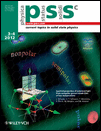MOVPE growth of InGaAsN films on Ge(001) on-axis and vicinal substrates
Abstract
The InGaAsN films were grown on Ge(001) on-axis and vicinal substrates by MOVPE varying the N concentration. Their surface morphologies and photoluminescence (PL) properties were investigated comparatively. The AFM images show submicron-sized anti-phase domains (APDs) for the growth on the on-axis substrates, while the single-phase domains with improved surface flatness are observed on the vicinal substrates. Lattice-matched InGaAsN film with In = 12.5% and N = 4.2% gives the 1.0 eV PL peak energy as is aimed at. The PL property shows basically no change on the vicinal substrates from the on-axis ones despite the extinction of the APDs. The temperature dependence of the PL peak energy shows the characteristic S-shape behavior, indicating the potential fluctuations due to the non-uniformity of N incorporation. The magnitude of the potential fluctuations estimated from the differences between the observed PL peak energies and the Varshni fitting curves suggests that the vicinal substrates may somehow degrade the compositional uniformity. (© 2012 WILEY-VCH Verlag GmbH & Co. KGaA, Weinheim)




